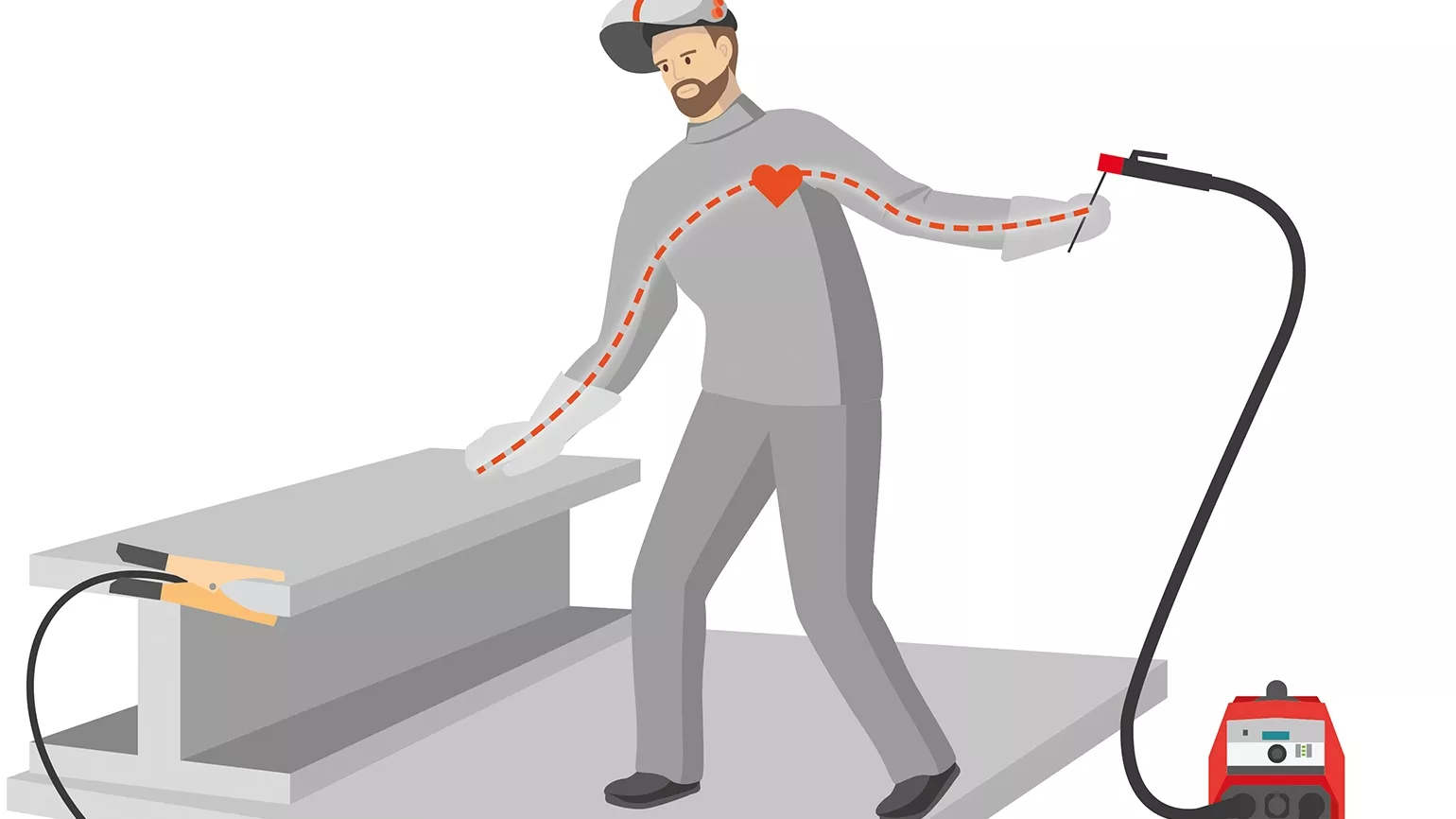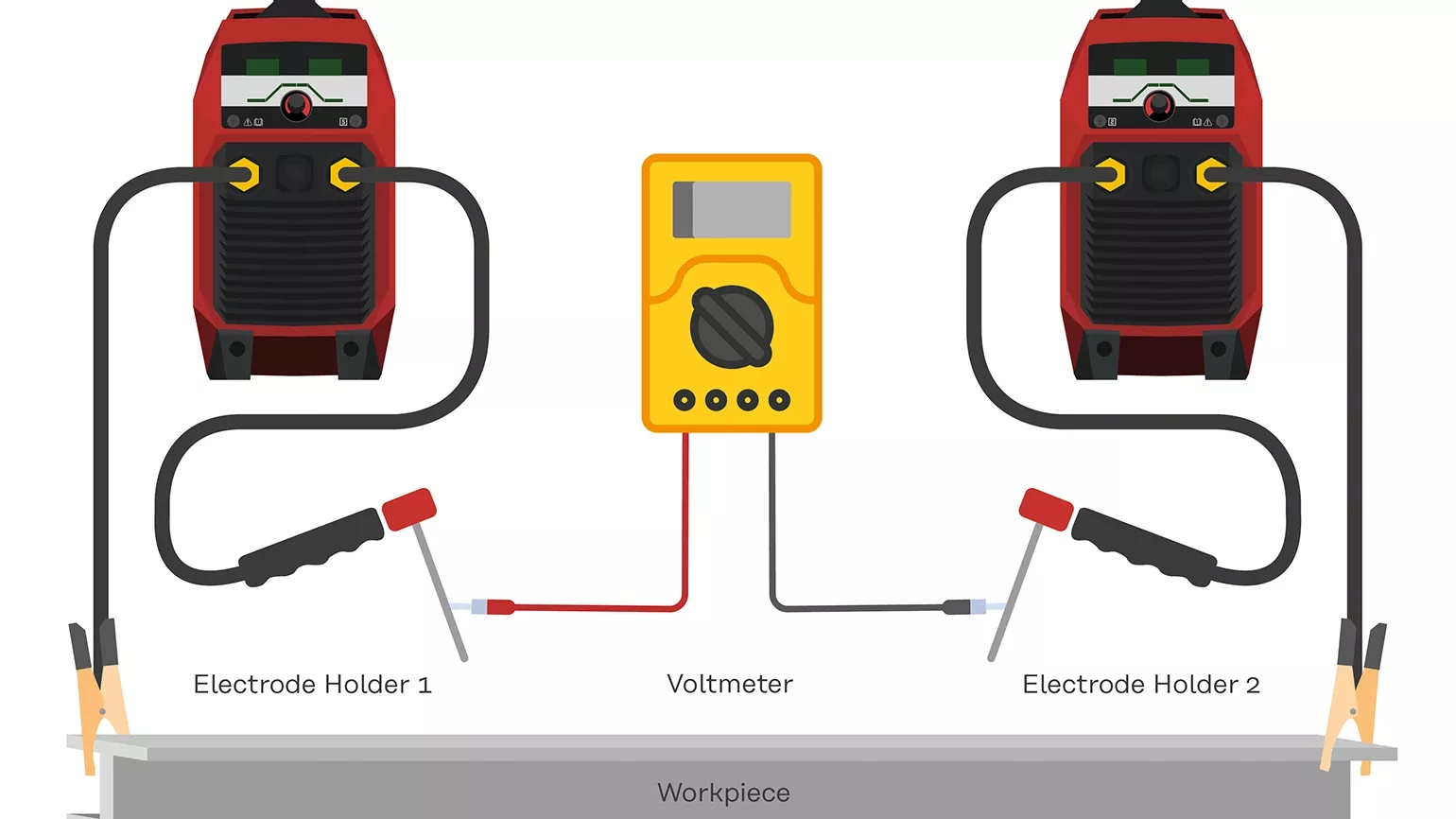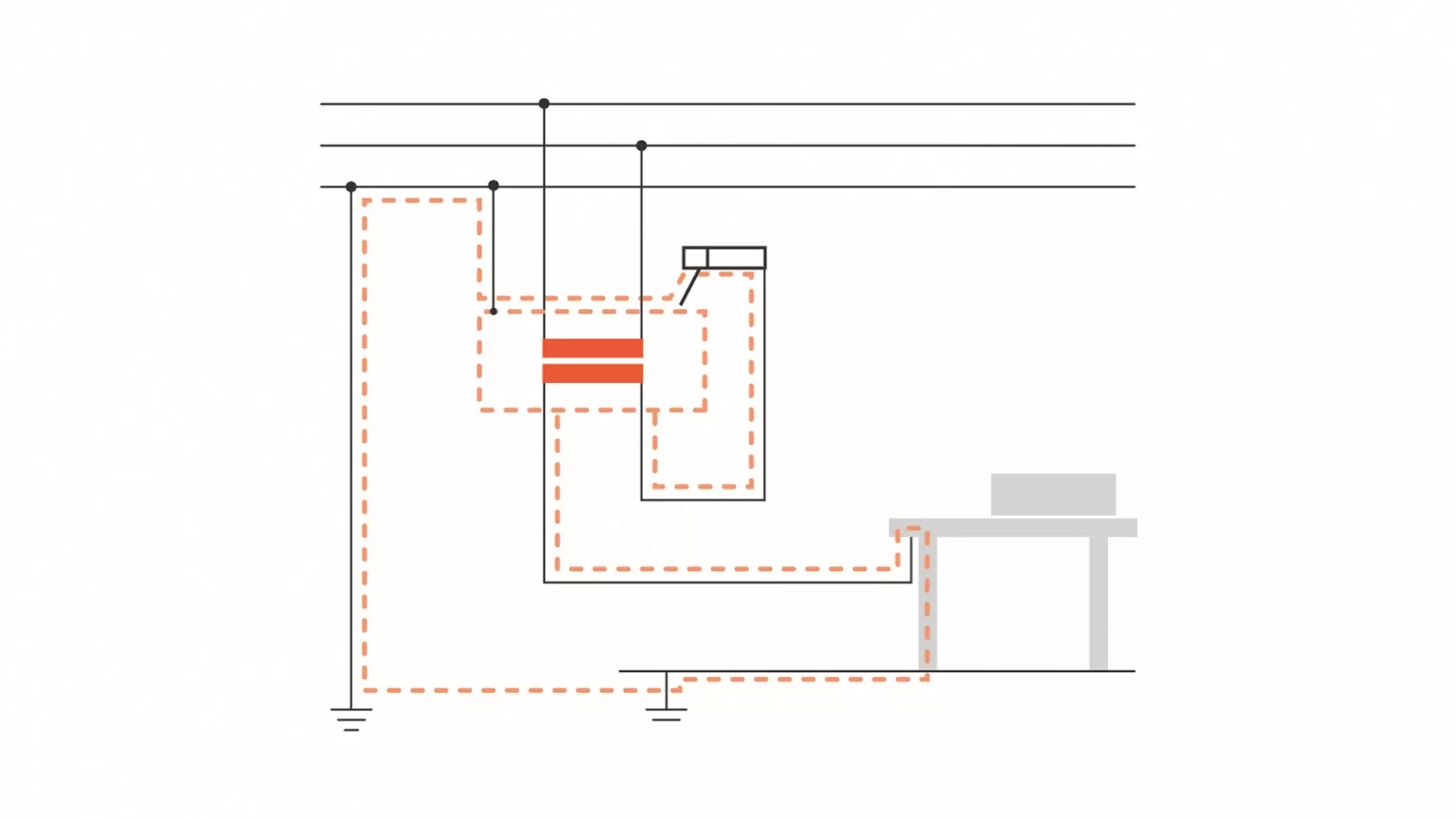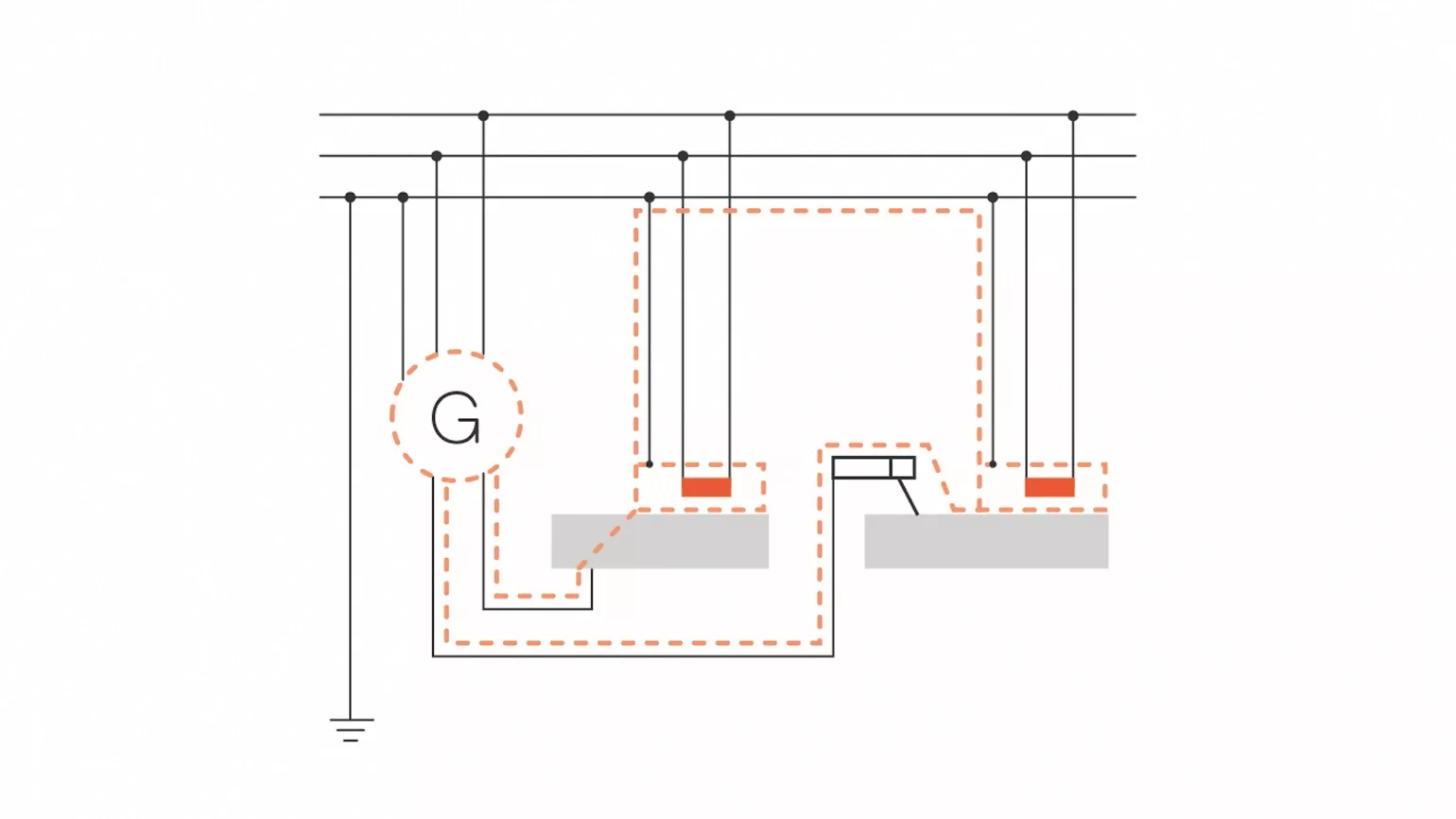Electrical current
The unseen hazard of welding

But one often underestimated aspect is a hazard that remains unseen: electrical current.
Electrical current always takes the shortest path through the body between the point of entry and the point of exit. If it runs through both hands, for example, the current not only flows through the arms and upper body, but also vital organs such as the heart—with potentially fatal consequences (drawing 1).

Caution around open circuit voltage
While live parts of commercially available electrical
appliances are protected against contact, arc welding poses an increased risk
because the open circuit voltage can become dangerous contact
voltage—especially if the workpiece (ground) and the electrode or non-insulated
parts of the electrode holder are touched at the same time. In this case, the
current travels through the human body.
Depending on the operating conditions, fixed maximum
limits apply to the open circuit voltage. There is an electrical hazard to
humans starting at voltages of more than 25 V AC (RMS) or
60 V DC and where there is the potential for a sufficiently high
current to flow at the same time.
Even low amperages can be lethal
When electrical current travels through the human
body, it has a stimulating effect on muscles, nerves, and the cardiovascular
system. Potential consequences range from muscle cramps and respiratory arrest
to “current marks”—small, point-like burns at the entry and exit points of the
current. Amperages of 30 milliamperes or more pose an acute risk to life.
The “let-go current” is between 10 and 15 mA for alternating current and
around 50 mA for direct current. If this threshold is exceeded, muscle
cramps can be so severe that those affected are no longer able to let go of
live parts without assistance—an especially high risk for welding specialists
in everyday working life.
Alternating current is considered to be significantly
more dangerous than direct current, as it can affect the heart’s natural rhythm
and trigger ventricular fibrillation. Another factor that often goes
underestimated is that even low amperages of between 1 and 10 mA are
sufficient to trigger involuntary reflex movements, which often result in
secondary accidents. These uncontrolled reactions could, for example, lead to a
fall from a ladder or other injuries.
In addition to the amperage, the duration of exposure
to the human body also plays a decisive role in the risk of injury. The longer
the flow of current lasts, the more serious the impacts on health. For this
reason, it is essential that welding specialists wear suitable protective
equipment at all times. In Europe, welding gloves must meet the requirements of
the EN 12477 standard, while work shoes should be protection class S3 in
accordance with EN ISO 20345.
How do you determine the danger?
The amperage (I) is dependent on the applied voltage (U) and the resistance (R) and follows Ohm’s law (U = R x I). If you want to determine the amperage, a human resistance (without protective equipment) of 1,000 ohms can be assumed from hand to hand or hand to foot. If the welding machine has an open circuit voltage of 50 V according to the rating plate, a potentially lethal current of 50 mA can pass through the body in accordance with Ohm’s law (I = U / R).
Caution when welding with several welding machines
If welding specialists are working on a workpiece with
several welding machines at the same time or on components with a conductive
connection, the contact voltage that occurs—especially the open circuit
voltage—can reach levels higher than permitted. In many cases, this hazardous
situation is not immediately evident.
But the situation becomes especially critical when
welding with different polarities at the same time. In this case, the total
open circuit voltages of the welding machines can lead to dangerously high
voltage levels when welding with direct current (DC).
“This
happens fairly often, especially on construction sites,”
reports Franz Bichler, a welding trainer at Fronius International. “In the past, we often worked in pairs or
threes when welding components several meters long—and even with different
polarities, to get the best results on complex components. If the grounding is
faulty in a situation like this, the accumulated voltage can pass through the
welder’s body—with life-threatening consequences such as electric shocks,
cardiac arrhythmia, or severe burns.”

The employer’s duty to protect and inform
Effective protective measures can prevent workplace
accidents, and the employer is responsible for making sure these are
implemented. International standards and regulations—such as those published by
the ISO (International Organization for Standardization), ASME (American
Society of Mechanical Engineers), AWS (American Welding Society), and DIN
(German Institute for Standardization)—form the basis for safe working
conditions.
Welding specialists must be informed of the
potential hazards in all cases. The distance between the welders must be
selected so that simultaneous contact with two welding torches or electrode
holders is ruled out. If this is not possible, the work areas must be separated
by insulating partitions. In addition, appropriate measurements need to be
taken to ensure that the total voltage does not exceed the maximum permissible
open circuit voltage.
What needs to be taken into account during welding?
Before starting work, welding specialists must ensure
that the welding machines they are using are in perfect condition. Those that
are not in use or are left unattended must be switched off and disconnected
from the power supply. Devices must always be operated in accordance with the
protection class shown on the rating plate—in compliance with the relevant
operating instructions.
Devices in protection class IP21 may only be used in
dry indoor areas. A protection class of IP23 is required as a minimum for
outdoor use. Return lead cables should be connected as close as possible to the
welding area—either directly to the workpiece or to its support.
In the event of faults, the power supply must be
disconnected immediately, either by switching off the device or removing the
mains plug. Any damage to welding machines, mains leads, or hosepacks must be
reported to the welding supervisor immediately. Under no circumstances may
defective devices be used again or opened without authorization—especially not
by removing the protective cover.
Hazards due to stray welding current
Carelessness and inattention are the most common causes of breaks in the ground conductor and resulting accidents. Typical examples might include uninsulated electrode holders that are set down on the welding machine or power hand tools left on the welding table during welding work (drawings 3 and 4).

If, in exceptional cases, workpieces have to be welded while suspended from a crane hook, they must be carefully shielded—for example, using dry textile ropes or an insulated swivel hook. In cases where suspended work baskets are used while welding, these must be fitted with suitable insulation. Only insulated equipment may be used when welding and working with power tools at the same time.

Working in conditions with high electrical voltage
You can use the following rule of thumb to assess whether there is an increased risk during arc welding: If the free space between electrically conductive parts positioned opposite one another is less than two meters—in length, width, height, or diameter—you should assume that there is an increased electrical risk.
Make sure to take particular care in wet, damp, or hot workplaces, as the resistance of human skin, protective clothing, and protective equipment may be significantly reduced by moisture or perspiration in these environments. Workplaces should be considered “wet” if workwear is soaked with moisture and can therefore conduct electricity—which significantly increases the risk of an electrical accident.
Protective measures in the event of increased
electrical risk
Only approved welding machines marked with the [S]
symbol may be used for work involving an increased electrical hazard. Special
protective measures are also required to ensure welding specialists are
protected from electrically conductive parts as well as damp floors and walls
by means of insulating underlays or intermediate layers of material.
If this shielding cannot be provided due to additional hazards—such as a risk of falling—or a lack of space, work may only be carried out while wearing dry, undamaged workwear. In situations where you cannot guarantee that clothing will remain dry, such as in hot environments, only direct current machines may be used for manual arc welding.
The open circuit voltage of the devices used should be kept as low as possible—depending on the welding tasks and device properties—and must not exceed 75 V. Welding machines must not be set up in the immediate danger zone. Protective extra-low voltage must be used for remote control of these devices.
Also ensure that welders do not work alone on these jobs—suitable supervision must be provided during welding. Only qualified specialists may carry out welding work involving an increased electrical hazard.
Summary and conclusion
Safety comes first when welding. Improper handling of
welding machines can have serious consequences—especially due to high open
circuit voltages, stray welding current, or when working in conditions
involving increased electrical hazards. However, these risks can be
significantly reduced by consistently observing suitable protective measures.
Special attention is required in wet, damp, or hot workplaces, where the protection provided by clothing and equipment may be impaired. If faults occur, appropriate steps must be taken immediately to prevent personal injury and damage to property.
